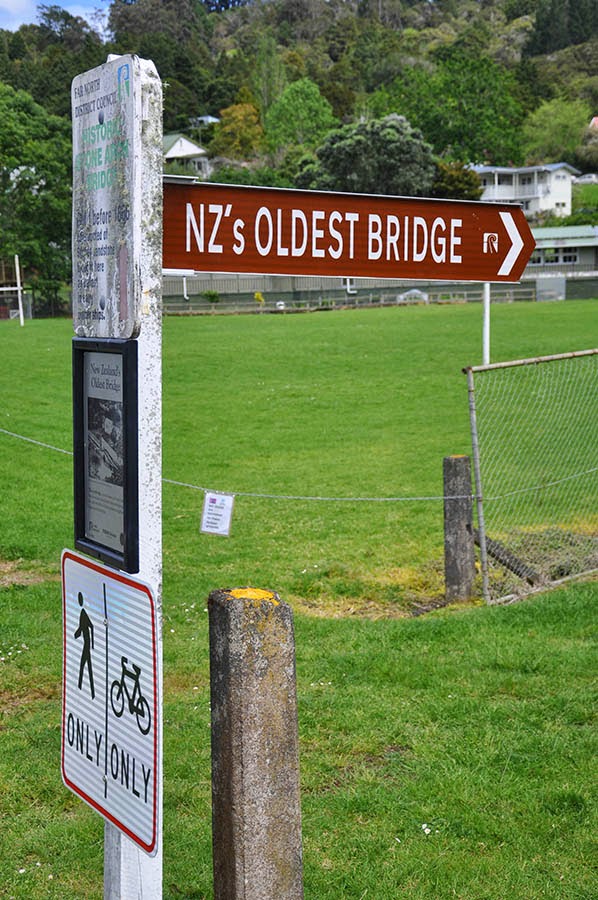“kohu“ translates to mist or fog - misty mornings promise a good day in Kohukohu, and you will have a lot of misty mornings here, especially in spring or autumn. You would not believe it nowadays, but Kohukohu was a busy port around the 1830’s. It was mainly a timber industry which turned into a dairy industry once timber was exhausted.
It was actually the third largest town north of Auckland. A lot of the commercial houses burnt down during two major fires. There used to be hotels, a newspaper office, a boatyard, a dentist, a few banks, a post office and shops. Nowadays you can visit the Village Arts Gallery, stop for a coffee or pizza, do the historic walk, relax and enjoy the harbour views. It is a great place to just slow down a bit on your journey up north.
“kohu“ bedeutet übersetzt so viel wie Nebel oder Dunst. Man sagt, man kann hier in Kohukohu einen schönen Tag erwarten, wenn es morgens neblig ist, ganz besonders im Frühling und Herbst. Um 1830 war im Hafen von Kohukohu viel los. Hauptsächlich fand man hier Holzindustrie und als die Holzvorräte erschöpft waren, wurden viele Milchprodukte hergestellt.
Es war die drittgrößte Stadt nördlich von Auckland, das kann man heute nur noch schwer glauben. Viele Geschäfte brannten wegen zweier großer Feuer nieder. Hier gab es so etwas wie einen Zeitungsverlag, einen Zahnarzt, viele Geschäfte, ein paar Banken, Gasthöfe und ein Postamt. Heute kann man in Kohukohu einen Spaziergang machen, der an den historischen Gebäuden vorbeiführt, oder man entspannt sich bei einer Tasse Kaffee in einem von beiden Cafés. Der Ausblick über den Hafen ist dabei sehr, sehr schön.
 |
| Lavender Cottage |
The houses here have one thing in common: they all look very neat and usually have dreamy gardens. If I had to pick a favourite house, I would probably take the Lavender Cottage. You keep noticing these little things in Kohukohu, just like the rainbow gate, that make you smile every now and then. Sometime it is just a smell your nose catches or a beautiful flower. I even found the Australian frangipani here.
Die Häuser haben alle eins gemein: sie sehen sehr hübsch aus und haben oft einen verträumten Garten davor. Mein Lieblingshaus hier ist wohl das Lavender Cottage. Das Besondere an Kohukohu sind die unerwarteten Kleinigkeiten wie das Regenbogengartentor, die dieses kleine Städtchen so besonders machen.
You can find New Zealand’s oldest bridge in Kohukohu - it is impossible to miss the sign. I was very curious about seeing it. I had imagined what it might look like before. It’s just between the bowling club and the school. Well, have a look:
Neuseelands älteste Brücke steht auch in Kohukohu und wird von einem unverfehlbaren Schild angekündigt. Man findet sie zwischen dem Bowlingclub und der Schule und würde wahrscheinlich etwas anderes erwarten:
 |
| Well, I had a look if there was another bridge around - but that's it. New Zealand's oldest bridge. |
You might have expected more, it is actually just a part of what the bridge used to be like. It was built between 1843 and 1851 with sandstone from Sydney. The bridge was built for Kauri builder George Russell. Horses and people could cross the Waihouuru Creek below the bridge. The bay next to the bridge filled with sawdust from the procession of kauri timber in the steam-powered mill. They covered the sawdust with rock and soil and you can only see the top of the arch nowadays. Still, it is New Zealand’s oldest bridge.
Etwas klein und nicht wirklich hilfreich für Neuseelands älteste Brücke, oder? Man kann nur mehr den obersten Teil des Brückenbogens sehen. Die ursprüngliche Brücke wurde zwischen 1843 und 1851 mit Sandstein aus Sydney für den Bauherren George Russell. Pferde und Menschen konnten so den Waihouuru Bach überqueren. Es lagerten sich Sägespäne neben der Brücke ab, die man mit Steinen und Erde auffüllte, und somit wurde die Brücke zugeschüttet. Immerhin, es ist immer noch Neuseelands älteste Brücke.
The main road has two little cafés and you can have a look at different artworks from local artists. It only gives you a glimpse of what Kohukohu might have looked like 150 years earlier. You will also find old cannons around the wharf and the war memorial arch.
After the second major fire in 1967, all that remained was the Post Office, the Library and the Butcher’s Shop. The fire hoses were too short to reach the water because the tide was not in and so many buildings of Kohukohu burnt down.
Auf der Hauptstraße findet man zwei gemütliche Cafés und eine kleine Kunstgallerie mit Werken von lokalen Künstlern. Man kann erahnen, wie Kohukohu wohl vor 150 Jahren ausgesehen haben muss. Einige historische Kanonen und ein Kriegsdenkmal gibt es auch am Anlegeplatz für die Schiffe.










Keine Kommentare:
Kommentar veröffentlichen